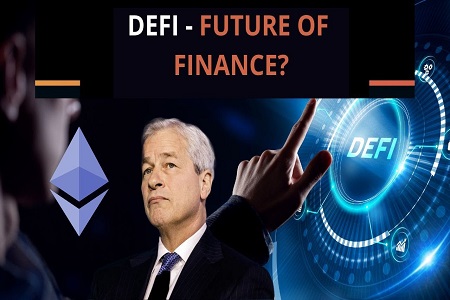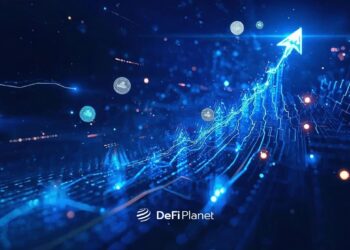Last updated on July 11th, 2023 at 11:36 pm
Away from the price action of Bitcoin, Ethereum, and altcoins, there is something quite extraordinary happening in the world of crypto, and that is, DeFi or Decentralized Finance.
This article will talk about what DeFi is all about, how it improves the traditional financial system, and why we believe it could be the future of banking and finance that humanity deserves.
Let’s dive in.
Is DeFi The Future?
Is DeFi the future? The answer to this question lies in our past and present.
Let’s consider the state of our current financial system. Our legacy financial infrastructure is plagued with inefficiencies that have led to both limited and unequal growth opportunities for people all across the world. The unfortunate statistic highlights the inequality that is around the world, over 1.7 billion people are unbanked. Moreover, even the small businesses and individuals who have access to banking services have to pay high service costs. As a result, there is a lack of investment and decreased economic growth in parts of the world where a large part of the population is still unbanked. Let’s try to understand this better with an example.
For instance, imagine an entrepreneur who has a high-quality idea that can accelerate economic growth and go to the bank to borrow money. But, because of the legacy costs of the traditional financial system, the loan rates become high, and the bank tells the entrepreneur to borrow money on her credit card at 24% per year. For an entrepreneur targeting a 20% rate of return, paying interest costs at 24% per year means that their profitable project can never be pursued. Hence, the economic growth accelerating project will never be able to start.
The example above shows how the current system perpetuates inequality due to the inherent legacy problems. Where there should be an equality of opportunity and the project should be financed based on the quality and the possible outcome of the idea execution, other factors are given more weightage in the existing system, limiting the growth because good ideas cannot be financed.
This is where DeFi comes in, and by offering numerous potential solutions to the inherent problems in the traditional financial infrastructure, DeFi poses a challenge to the current system.
Thus, we believe that in the future, the financial systems that embrace decentralized methods – in particular, blockchain technology and smart contracts – have the best chance to define the future of finance.
How DeFi Will Change The Future Of Financing
Unlike traditional finance that relies on old and inefficient infrastructure, DeFi attempts to build a new financial system by leveraging the power of blockchain technology, smart contracts, cryptography, and decentralization.
Using the underlying technology introduced by Bitcoin and Ethereum, DeFi aims to create a financial system that is more fair, efficient, and open to all. It attempts to provide legacy financial services such as payments, lending, borrowing, and trading but with a twist by removing the central intermediaries that play a key role in the legacy financial system.
A peer-to-peer system that is not monitored or controlled by any centralized authority, DeFi is essentially just like a bank. But, as there is no centralized institution involved, there are no bricks and mortar and no loan interviews. Instead, one can simply deal with other market participants algorithmically in an environment secured by blockchain technology.
Moreover, by cutting out the central figure in the system, DeFi can significantly reduce costs and thus make the financial services more affordable for all. Furthermore, DeFi democratizes finance since here, everyone is treated the same, thus reducing the inequality of opportunity problems that exist in the current system.
By making finance more affordable and accessible to all, DeFi will change the future of financing.
Is DeFi The Future of Banking That Humanity Deserves?
The financial system that we have today has gone through many changes, and with DeFi, humanity has become full circle. First, we started with a highly efficient market exchange, also known as the barter system. Here, the supply and demand between market participants had to be matched precisely for an exchange to occur. Then, non-centralized money was introduced as a medium of exchange and a store of value to solve this problem of matching the demand and supply. Market participants used any form and number of items such as stones or food grains in exchange for goods. This non-centralized form of money eventually evolved into a currency that has tangible value and today is known as fiat currency that central banks manage across the world. Throughout this process, while the form of money has changed, we have not witnessed a change in the infrastructure of financial institutions.
The constant change in DeFi calls for the inefficient legacy infrastructure of the financial infrastructure to be upgraded. Using blockchain technology, DeFi aims to build an open-source financial system that offers financial products to users similar to those provided by the legacy financial system but in a more efficient and frictionless manner.
Since DeFi removes the intermediaries and the inefficiencies involved in the traditional financial system, it can reduce the cost users can avail of the services. Moreover, being open-source and permissionless, anyone from anywhere globally, irrespective of financial background, race, caste, sex, etc., can access the decentralized financial system. Thus, DeFi is creating a world of finance that is more affordable and accessible to all humans. Thus, we believe that DeFi is the future of banking that humanity deserves, and a day will come in the future where DeFi will replace TradFi.
How Beneficial Is DeFi To TradFi?
To understand how DeFi is beneficial in comparison to TradFi, let’s first take a look at the differences between the two:
Point of Difference | TradFi | DeFi |
| Autonomy | An institution or a central authority manages the operations. | DeFi applications don’t have restricted access. Instead, everything is done through smart contracts, and the storage is carried directly in the blockchain. |
| Availability | Users have to be present at the physical location of the TradFi service provider or at least be present in the legal jurisdiction where the institution functions, | DeFi applications are available from anywhere in the world, at any time of the day. One only requires an internet connection to use DeFi apps or DApps. |
| Transparency | All operations are private and in most cases, no one can find more information about how TradFi institutions function. | The DeFi space is open-source. This means that the source code of all the DApps is publically available for anybody to look at and audit. |
| Disintermediation | One has to go through third-party intermediaries. For example, to invest in the securities market, one has to go through a bank. | Anyone and everyone can build their own application on top of smart contracts for DeFi. |
| Interoperability | Since the operations and the functions of TradFi institutions are private, the concept of interoperability largely does not exist in TradFi. | DApps can be run on different blockchains. Moreover, applications can be built by combining other DApps. |
Source: DeFi: Defining the future of finance
Let’s take a look at how DeFi is more beneficial to TradFi:
- Efficient – All operations are settled almost instantly irrespective of where the counterparties are situated, or which laws and regulations apply to them. Moreover, since DApps are largely automated, all processes are more efficient.
- Fair – As all the services are completely permissionless and censorship-resistant, the DeFi ecosystem is fair.
- Permissionless – Anyone with an internet connection can access DeFi services from anywhere in the world, at any time of the day.
- Censorship-resistant – No one can be denied access to DeFi services. Moreover, being decentralized, even multiple bad accords cannot change the rules.
- Open – Anyone can build a DeFi application and contribute to the ecosystem.
- Transparent – Since DeFi is built using blockchain technology, the ecosystem is transparent and everything is visible on the blockchain.
Should Blockchain Experts Expect Any More Evolution After DeFi?
While blockchain technology began as the basis of cryptocurrencies such as Blockchain, it has spread across a wave of industries beyond banking and cryptocurrency.
Today, millions of people around the world are using blockchain technology to build the DeFi space. This new ecosystem is powered by code and is revolutionizing the world of finance.
DeFi is eating TradFi – this statement sounds logical and inevitable today, but only a few years ago, the DeFi space did not even exist. Thus, one can never predict what lies in the future. So while today it might seem like we might have peaked with DeFi, it is also possible that DeFi is just the beginning of what lies ahead.
In Conclusion…
- TradFi will have to adapt quickly or risk becoming irrelevant in the future. The promise of DeFi allows us to imagine a future where legacy financial services are accessible to anyone around the world. With just a smartphone and an internet connection, one can avail of all the TradFi features at the comfort of their home.
- DeFi is still very far from truly revolutionizing the financial system. To do so, it will have to drastically improve its user interface so that people can actually use it. Otherwise, DeFi will just become an open and more efficient system of finance but without any real use if people cannot leverage the technology.
So, what do you think is the future of finance? Is DeFi better than the current financial system?
Comment down below and let us know what you think!
If you would like to read more articles like this, follow DeFi Planet on Twitter and LinkedIn.





















